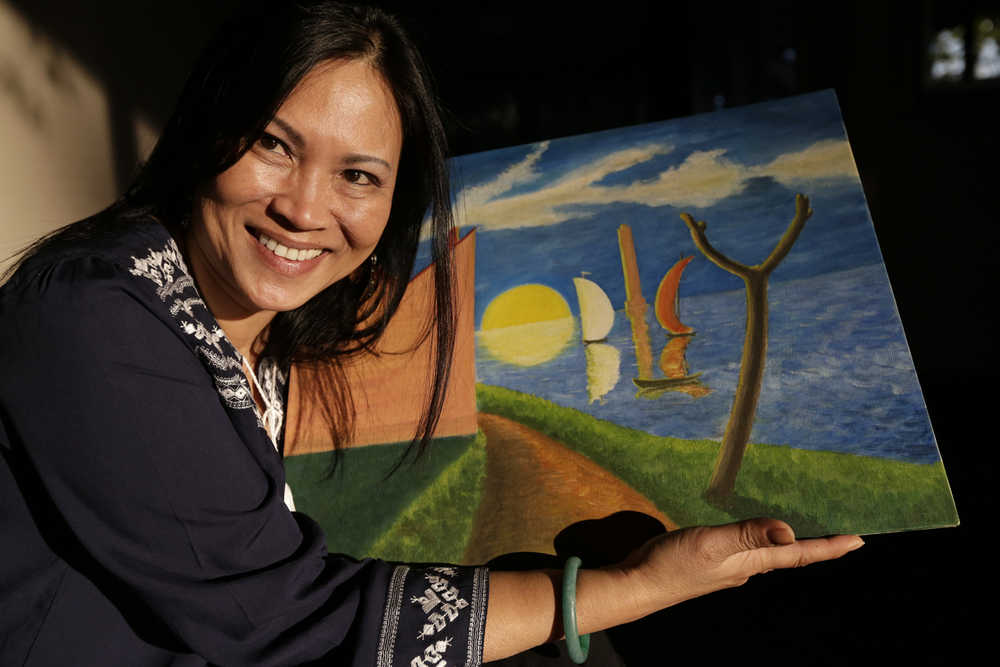SAN DIEGO — Erika Colligan spent three decades searching for her father’s artwork — paintings the South Vietnam pilot made for the U.S. Air Force aviators who trained him during the Vietnam war.
The 50-year-old San Diego software consultant was only 1 when her father died in a plane crash in his native country in 1966.
At age 10, her family fled Vietnam and came to the United States, leaving behind their belongings and his artwork. Colligan believes most of his paintings were destroyed after the Communist government took power, but she kept faith some of the artwork Phan Khoi made for his American friends was still out there, offering a tangible sliver of the father she never got the chance to know.
For decades she showed veterans a faded photograph of Khoi sitting with a paintbrush and two portraits in his room at a U.S. Air Force base. She posted the image repeatedly online, asking if anyone recognized the American pilot in one of the portraits.
Her search paid off about three months ago when it led her to Khoi’s former Air Force instructor, retired Col. Billy Mobley.
Mobley told her in an email that Khoi had given him a painting — a serene landscape that has hung on his wall for more than 50 years. Colligan immediately drove to Mobley’s house in Stephenville, Texas.
“He grabbed hold of my face and said, ‘Yep, you’re Phan Khoi’s daughter all right,’” Colligan said.
He then handed her the painting.
“I took the painting and cradled it for half an hour and cried a lot,” she said.
She ran her finger over her father’s signature on the back. She and Mobley talked well past midnight that cold December day. She learned her father was a quiet, serious man, a surprise to the outgoing woman with an easy laugh.
“It did not bring me closure, instead it marked a beginning for me,” she said later.
Mobley, now 83, was overwhelmed as well.
“That hit me right in the heart,” he said of Colligan’s visit. “Phan Khoi gave me that painting in 1962 and then here was his daughter standing in front of me.”
Khoi was among more than 1,500 Vietnamese pilots sent to the United States for training.
The U.S. military helped build the South Vietnam Air Force to be among the ten largest air forces in the world in 1974.
U.S. military instructors would spend up to a year alongside the pilots, inviting them to their homes for barbecues and holiday dinners, despite the cultural and language barriers. But once the training ended, most of the U.S. instructors lost contact with their students.
After the Fall of Saigon in 1975, the South Vietnam Air Force dissolved. Many of the South Vietnam pilots returned to the United States, this time as refugees battling discrimination in their adopted country.
“They were such dedicated, such honorable men and we didn’t know what had happened to them,” Mobley said. “Then I get this email from a lady looking for her father.”
Colligan learned that the two portraits in the faded photograph she had shared with veterans for decades were paintings her father made for his other Air Force instructor, Doyle Ruff, who appears as the young pilot in one portrait; the other was of Ruff’s daughter, Rebecca, who was two at the time.
After contacting him, retired Col. Ruff sent Colligan a birthday card Khoi had given him in 1963, and later Ruff’s ex-wife sent her the two portraits, and shared her own memories.
In early January, Colligan organized a reunion with Mobley, Ruff, other Air Force officers and some of the South Vietnam pilots they had trained more than a half century ago. She and her family spent two days at a San Diego hotel, mostly listening to the men reminisce about grumpy instructors, the risks of flying then and the pilot who loved to paint.
In the room where they chatted was the painting Khoi made for Mobley. Colligan felt almost as if her father was there.
Now that she has seen his paintings in person, she can see that her father would paint the name of the person into the background, as if hiding a clue. Her search continues to lead her to more people who knew Khoi.
“I think my father is doing this,” she said of her search. “My objective is still to find his artwork but along this journey I’ve been able to learn what my father was like. It’s been a great journey.”

